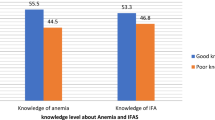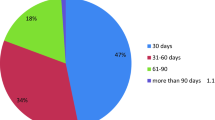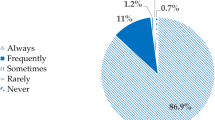Abstract
Background/Objectives:
Despite repeated public commitments and availability of various forms of iron supplements, rates of anaemia in developing countries remain high. A major reason for this lack of success has been poor adherence. The objective of this study was to compare the effectiveness of daily and flexible administration of micronutrient Sprinkles on adherence, acceptability and haematological status among young children in rural Bangladesh.
Subjects/Methods:
A sample of 362 children (haemoglobin (Hb)⩾70 g l−1) aged 6–24 months were cluster-randomized to receive 60 sachets of Sprinkles either (i) daily over 2 months; (ii) flexibly over 3 months; or (iii) flexibly over 4 months. With a flexible regimen, mothers/caregivers decided how frequently to use Sprinkles without exceeding one sachet per day. Adherence was assessed monthly by counting the number of sachets used and acceptability was evaluated through focus group discussions. Haemoglobin was measured at baseline, at the end of each intervention period and 6 months post-intervention.
Results:
Mean percent adherence was significantly higher in the flexible-4-month group (98%) compared to the flexible-3-month (93%) and daily-2-month (88%) groups (P<0.01). Most mothers found flexible administration to be more acceptable than daily due to perceived benefits of use. Hb at the end of intervention was significantly higher in the flexible-4-month group compared to the daily group (P=0.03). Anaemia prevalence decreased by 65% in the flexible-4-month group compared to 54% in the flexible-3-month and 51% in the daily-2-month groups. Percent of cured children who maintained a non-anaemic status 6 months post-intervention was significantly higher in the flexible-4-month (82%) and flexible-3-month (80%) groups than the daily-2-month (53%) group (P<0.05).
Conclusions:
The adherence, acceptability and haematological response to flexible administration over 4 months were found preferable to daily.
This is a preview of subscription content, access via your institution
Access options
Subscribe to this journal
Receive 12 print issues and online access
$259.00 per year
only $21.58 per issue
Buy this article
- Purchase on Springer Link
- Instant access to full article PDF
Prices may be subject to local taxes which are calculated during checkout



Similar content being viewed by others
References
ACC/SCN (2004). Nutrition for Improved Development Outcomes: 5th Report on the World Nutrition Situation. Administrative Committee on Coordination, Subcommittee on Nutrition: Geneva.
Ahmed F (2000). Anaemia in Bangladesh: a review of prevalence and aetiology. Public Health Nutr 3, 385–393.
Ahmed SM, Adams AM, Chowdhury M, Bhuiya A (2003). Changing health-seeking behaviour in Matlab, Bangladesh: do development interventions matter? Health Policy Plan 18, 306–315.
BBS/UNCF (2004). Anaemia Prevalence Survey of Urban Bangladesh and Rural Chittagong Hill Tracts 2003. Bangladesh Bureau of Statistics/United Nation's Children's Fund: Dhaka.
BRAC (2002). Annual Report. Bangladesh Rural Advancement Committee: Dhaka.
Ciomarten T, Nanu R, Iorgulascu D, Moldovanue F, Popa S, Palicari G (1995). Iron supplement trial in Romania. In: Nestel P (ed). Proceedings, Iron Interventions for Child Survival. USAID and ICH: London, pp 89–98.
Cohen AR, Seidl-Friedman J (1988). HemoCue system for hemoglobin measurement. Evaluation in anemic and nonanemic children. Am J Clin Pathol 90, 302–305.
Davidsson L, Jamil KA, Sarker SA, Zeder C, Fuchs G (2004). Human milk as a source of ascorbic acid: no enhancing effect on iron bioavailability from traditional complimentary food consumed by Bangladeshi infants and young children. Am J Clin Nutr 79, 1073–1077.
DeMaeyer EM, Dallman P, Gurney JM, Hallberg L, Sood SK, Srikantia SG (1989). Preventing and Controlling Iron Deficiency Anaemia Through Primary Health Care: a Guide for Health Administrators and Programme Managers. World Health Organization: Geneva.
Galloway R, McGuire J (1994). Determinants of compliance with iron supplementation: supplies, side effects, or psychology? Soc Sci Med 39, 381–390.
Gibson RS, Ferguson EL, Lehrfeld J (1998). Complementary foods for infant feeding in developing countries: their nutrient adequacy and improvement. Eur J Clin Nutr 52, 764–770.
Giovannini M, Sala D, Usuelli M, Livio L, Francescato G, Braga M et al. (2006). Double-blind, placebo-controlled trial comparing effects of supplementation with two different combinations of micronutrients delivered as Sprinkles on growth, anemia, and iron deficiency in Cambodian infants. J Pediatr Gastroenterol Nutr 42, 306–312.
Grantham-McGregor S, Ani C (2001). A review of studies on the effect of iron deficiency on cognitive development in children. J Nutr 131, 649S–666S; discussion 666S–668S.
Hirve S, Bhave S, Bavdekar A, Naik S, Pandit A, Schauer C et al. (2007). Low dose ‘Sprinkles’—an innovative approach to treat iron deficiency anaemia in infants and young children. Indian Pediatr 44, 91–100.
HKI/IPHN (2000). High Anemia Prevalence Among Bangladeshi Children in Urban Slums: An Ethical and Economic Rationale for Multi-Micronutrient Supplementation?: Nutritional Surveillance Project Urban Anemia Prevalence Bulletin. Hellen Keller International and Institute of Public Health Nutrition: Dhaka.
Hyder SMZ, Haseen F, Rahman M, Tondeur MC, Zlotkin SH (2007). Effect of daily vs once weekly home fortification with micronutrient Sprinkles on hemoglobin and iron status among young children in rural Bangladesh. Food Nutr Bull 28, 156–164.
Khan ME (1990). Breast-feeding and weaning practices in India. Asia Pac Popul J 5, 71–88.
Levin L (1981). Self-care in health: potentials and pitfalls. World Health Forum 2, 177–184.
Lozoff B, De Andraca I, Castillo M, Smith JB, Walter T, Pino P (2003). Behavioral and developmental effects of preventing iron-deficiency anemia in healthy full-term infants. Pediatrics 112, 846–854.
Lozoff B, Jimenez E, Hagen J, Mollen E, Wolf AW (2000). Poorer behavioral and developmental outcome more than 10 years after treatment for iron deficiency in infancy. Pediatrics 105, E51.
Mora JO (2002). Iron supplementation: overcoming technical and practical barriers. J Nutr 132, 853S–855S.
Nestel P, Alnwick D (1997) Iron/multi-micronutrient supplements for young children. Summary and conclusions of consultation. UNICEF, Copenhagen, August 19–20, 1996. Washington, DC: International Life Sciences Institute.
Nestel P, Briend A, de Benoist B, Decker E, Ferguson E (2003). Complementary food supplements to achieve micronutrient adequacy for infants and young children. Pediatr Gastroenterol Nutr 36, 316–328.
NIPORT (2004). Bangladesh Demographic and Health Survey. National Institute of Population Research and Training, Mitra and Associates and ORC Macro: Dhaka.
Scrimshaw SCM, Hurtado E (1987). Rapid Assessment Procedures for Nutrition and Primary Care: Anthropological Approaches to Improving Programme Effectiveness. UCLA Latin American Center Publication: Tokyo.
Sharieff W, Wu M, Yin S, Yang Q, Schauer C, Asante KP et al. (2006). Weekly Administration of Micronutrient Sprinkles in School has High Compliance and Does not Cause Iron Overload in Chinese Children: A Cluster-Randomized Trial. Public Health Nutrition 9, 336–344.
Stoltzfus RJ, Dreyfuss ML : Guidelines for use of iron supplements to prevent and treat iron deficiency anaemia. INACG/WHO/UNICEF, 1998.
Tondeur MC, Schauer CS, Christofides AL, Asante KP, Newton S, Serfass RE et al. (2004). Determination of iron absorption from intrinsically labeled microencapsulated ferrous fumarate (Sprinkles) in infants with different iron and hematologic status by using a dual-stable-isotope method. Am J Clin Nutr 80, 1436–1444.
UNICEF/MI (2004). Vitamin and Mineral Deficiency A Global Progress Report. The Micronutrient Initiative: Ottawa.
UNICEF/UNU/WHO/MI. Preventing Iron Deficiency in Women and Children: Technical Consensus on Key Issues, (1999): International Nutrition Foundation: Boston, MA.
Viteri FE (1996). Weekly compared with daily iron supplementation. Am J Clin Nutr 63, 610–612.
WHO (1993). Measuring Changes in Nutritional Status. World Health Organization: Geneva.
Zlotkin S, Arthur P, Antwi KY, Yeung G (2001). Treatment of anemia with microencapsulated ferrous fumarate plus ascorbic acid supplied as Sprinkles to complementary (weaning) foods. Am J Clin Nutr 74, 791–795.
Zlotkin S, Arthur P, Schauer C, Antwi KY, Yeung G, Piekarz A (2003). Home-fortification with iron and zinc Sprinkles or iron Sprinkles alone successfully treats anemia in infants and young children. J Nutr 133, 1075–1080.
Zlotkin SH, Schauer C, Christofides A, Sharieff W, Tondeur MC (2005). Micronutrient Sprinkles to control childhood anaemia. PLoS Med 2, 24–28.
Acknowledgements
We thank and acknowledge the colleagues at BRAC including Fazlul Karim, Nuzhat Choudhury, Mizanur Rahman, Late MG Sattar and Imran Matin for their support. We thank Mélody Tondeur for her contribution in reviewing the manuscript. Finally, we thank the mothers and the community at large without whom this research project would not have been successfully completed. This study was funded by the Hospital for Sick Children through a generous grant from the HJ Heinz Company Foundation, Pittsburg, USA.
Author information
Authors and Affiliations
Corresponding author
Rights and permissions
About this article
Cite this article
Ip, H., Hyder, S., Haseen, F. et al. Improved adherence and anaemia cure rates with flexible administration of micronutrient Sprinkles: a new public health approach to anaemia control. Eur J Clin Nutr 63, 165–172 (2009). https://doi.org/10.1038/sj.ejcn.1602917
Received:
Revised:
Accepted:
Published:
Issue Date:
DOI: https://doi.org/10.1038/sj.ejcn.1602917
Keywords
This article is cited by
-
Effect of low-iron micronutrient powder (MNP) on the composition of gut microbiota of Bangladeshi children in a high-iron groundwater setting: a randomized controlled trial
European Journal of Nutrition (2021)
-
Four years after implementation of a national micronutrient powder program in Kyrgyzstan, prevalence of iron deficiency and iron deficiency anemia is lower, but prevalence of vitamin A deficiency is higher
European Journal of Clinical Nutrition (2019)
-
Fortified food supplementation in children with reduced dietary energy and micronutrients intake in Southern Mexico
Nutrition Journal (2018)
-
Adherence to and acceptability of home fortification with vitamins and minerals in children aged 6 to 23 months: a systematic review
BMC Public Health (2016)
-
Effect of micronutrient powder supplementation for two and four months on hemoglobin level of children 6–23 months old in a slum in Dhaka: a community based observational study
BMC Nutrition (2016)



